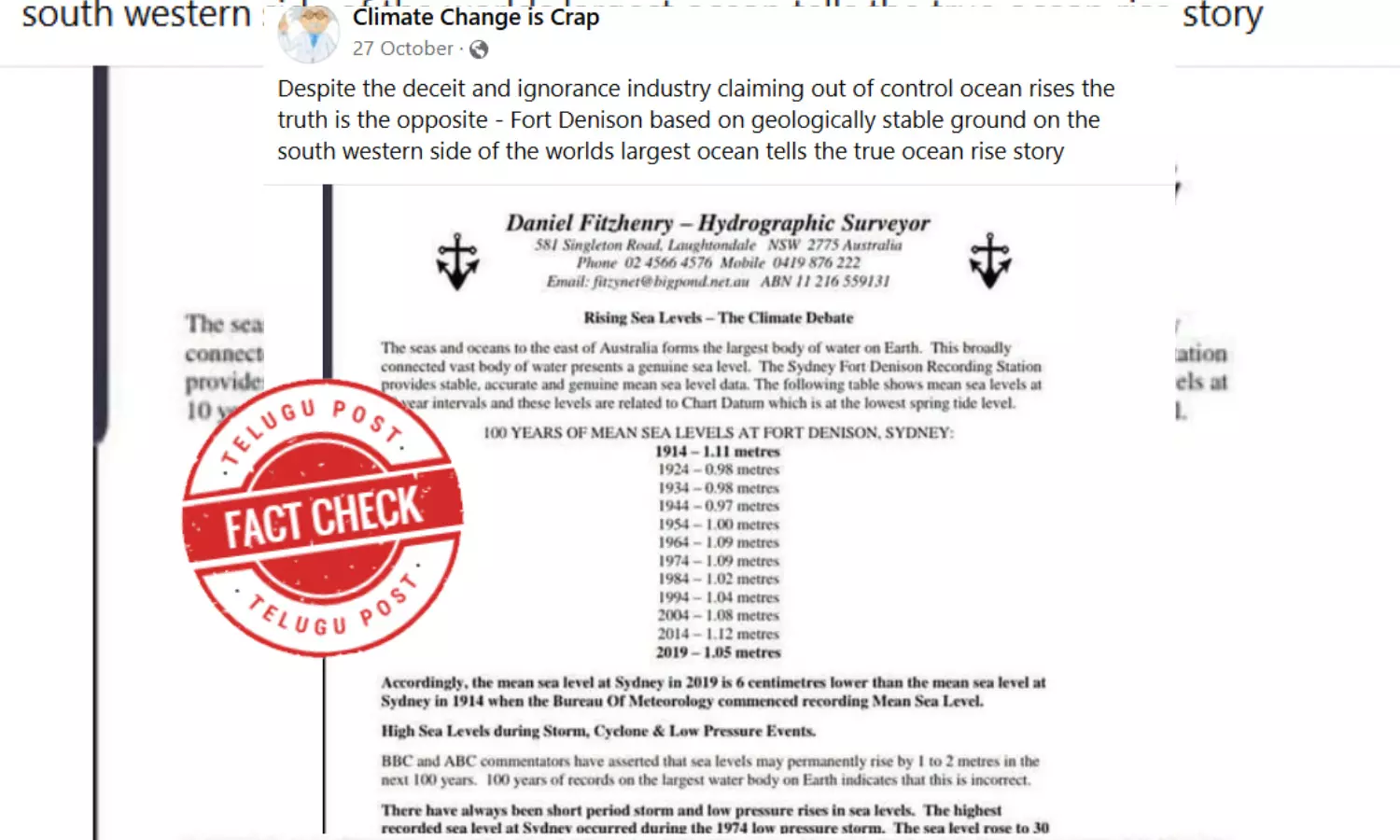Fact Check: Misleading Data Used to Claim Sea-levels are Declining in Sydney and Worldwide
Misleading Data Used to Claim Sea-levels are Declining in Sydney and Worldwide

Claim :
A post presents data about sea-level changes in Sydney, Australia, between 1914 and 2019. The table in the document suggests that sea-levels in 2019 were lower than in 1914, challenging the widely accepted scientific consensus on global sea-level rise. It implies that this data represents the "true ocean rise story," allegedly debunking claims of rising sea-levels due to global warming.Fact :
The claim is misleading, as it misrepresents data and ignores scientific evidence
A viral Facebook post features a document claiming that sea-levels in Sydney area have decreased since 1914, presenting it as "the true ocean rise story." The post includes a table purportedly showing sea-level data from Fort Denison in Sydney for various years between 1914 and 2019, with the 2019 level listed as lower than 1914.
The caption reads, "Despite the deceit and ignorance industry claiming out of control ocean rises, the truth is the opposite. Fort Denison based on geologically stable ground on the south western side of the world's largest ocean tells the true ocean rise story."
The post has been shared over 2,000 times.
Click here to view the link.
Fact Check:
The claim is Misleading.
Scientific evidence, including data from government sources, confirms that global sea-levels have risen since 1914. Local sea-levels at Fort Denison in Sydney Harbor have also risen during this period. The data cited in the post does not represent annual average sea-levels, which is the standard measurement method. In fact, the annual average sea-level at Fort Denison in 2019 was higher than in 1914.
Global Sea Levels Are Rising, Sydney Included
NASA and other scientific organizations have documented a steady rise in global sea-levels due to global warming. Rising temperatures cause ocean water to expand and ice sheets to melt, adding more water to the oceans.
Ben Hague, a climate scientist at the Australian Bureau of Meteorology, confirmed that sea-levels have risen at Fort Denison since 1914. Analysis indicates an approximate rise of 0.07 inches (1.9 mm) per year from 1914 to 2018. However, data prior to 1966 is considered less reliable.
From 1966 onward, analysis shows a more precise trend:
- A rise of about 0.08 inches (2.17 mm) per year between 1966 and 2019.
- A steeper rise of 0.22 inches (5.59 mm) per year from 1993 to 2019.
Additional data from the U.S. National Oceanic and Atmospheric Administration (NOAA) reports a long-term sea-level rise of approximately 0.03 inches (0.8 mm) annually at Fort Denison since 1886.
Errors in the Document Cited by the Facebook Post
Daniel Fitzhenry, the document's creator, told USA TODAY that the sea-level values were sourced from Australian Bureau of Meteorology data. However, they represent the highest monthly mean sea levels for each year, not the annual average sea levels typically used in scientific analysis.
For example, the table lists the highest monthly mean sea-level for 1924 as 0.98 meters (38.5 inches), recorded in April. However, the annual average sea-level for 1924 was lower—approximately 0.88 meters (34.6 inches).
This discrepancy applies to most of the values in the table. When all data is included in calculations, Fort Denison’s annual average sea-level was higher in 2019 (1.01 meters) than in 1914 (0.98 meters), contradicting the claim in the post.
Misinterpretation of Sea-Level Data
Hague explained that sea-levels fluctuate annually due to weather and ocean variables, so a single year or month cannot be used to establish a trend. Reliable analysis requires examining long-term patterns using methods like linear trends that account for data from all years.
Additionally, sea-levels vary globally due to factors like:
- Local current and wind patterns.
- Variations in gravitational forces.
- Glacial isostatic adjustment, where land slowly rebounds from the weight of past glaciers.
Thus, local sea-level changes, even if they appear to decline in one area, cannot be used to make global conclusions.
Conclusion
Global sea levels are rising, with Fort Denison and Sydney showing the same trend. While it is possible for sea-levels to decline in some areas due to local factors, this does not reflect the global pattern.
